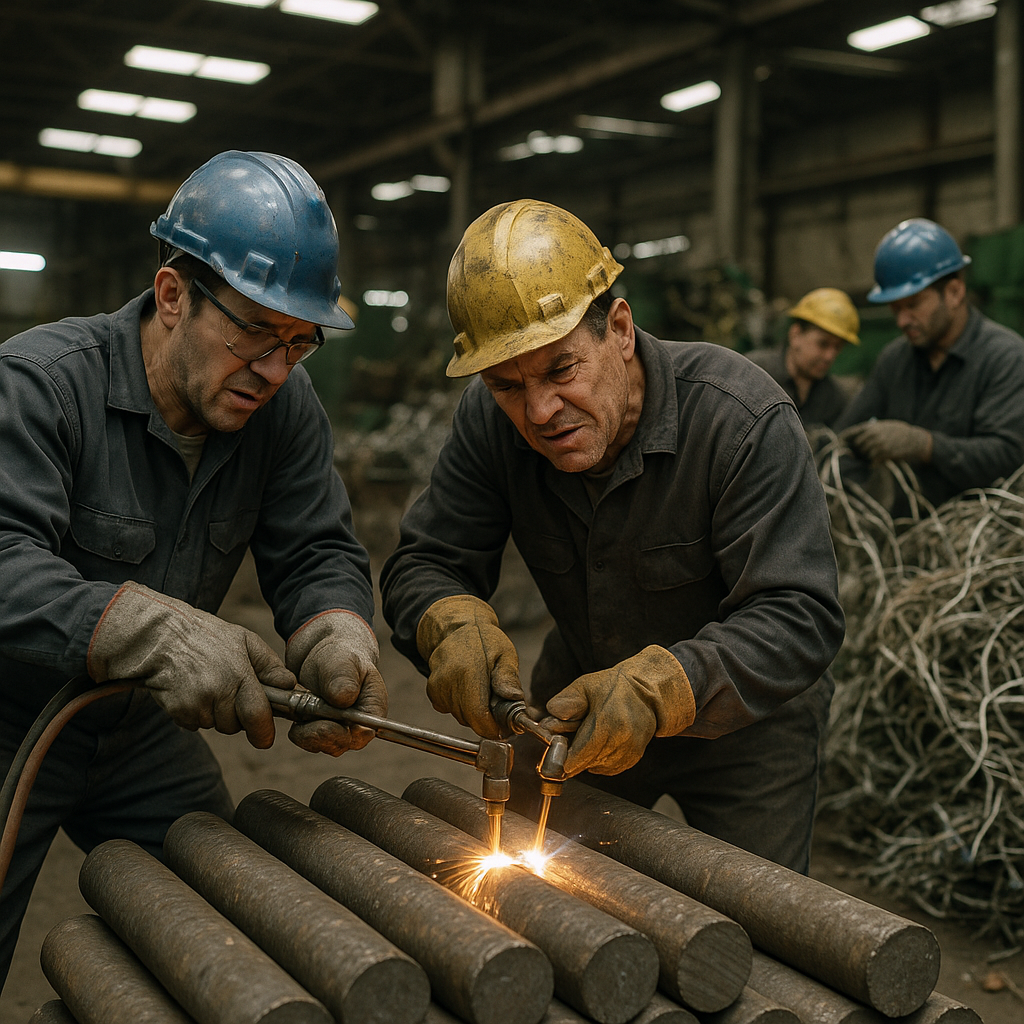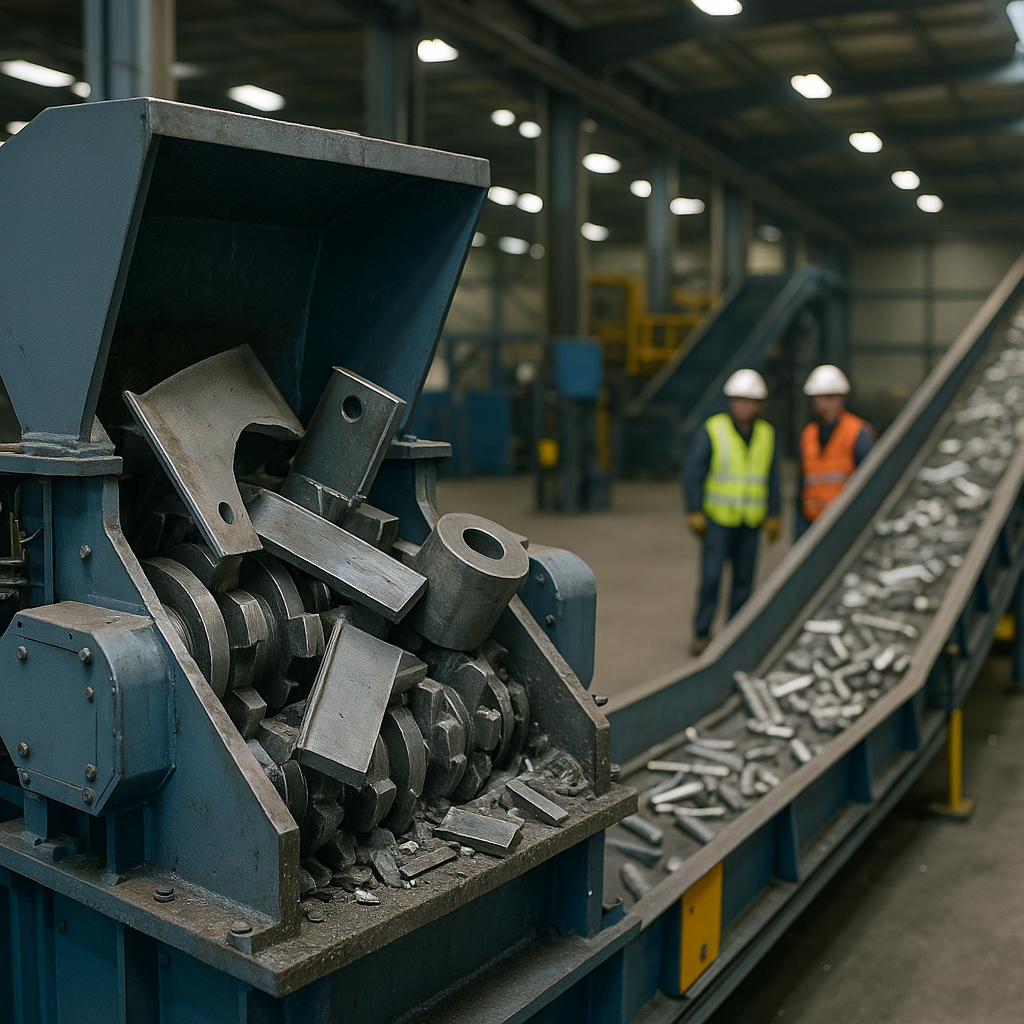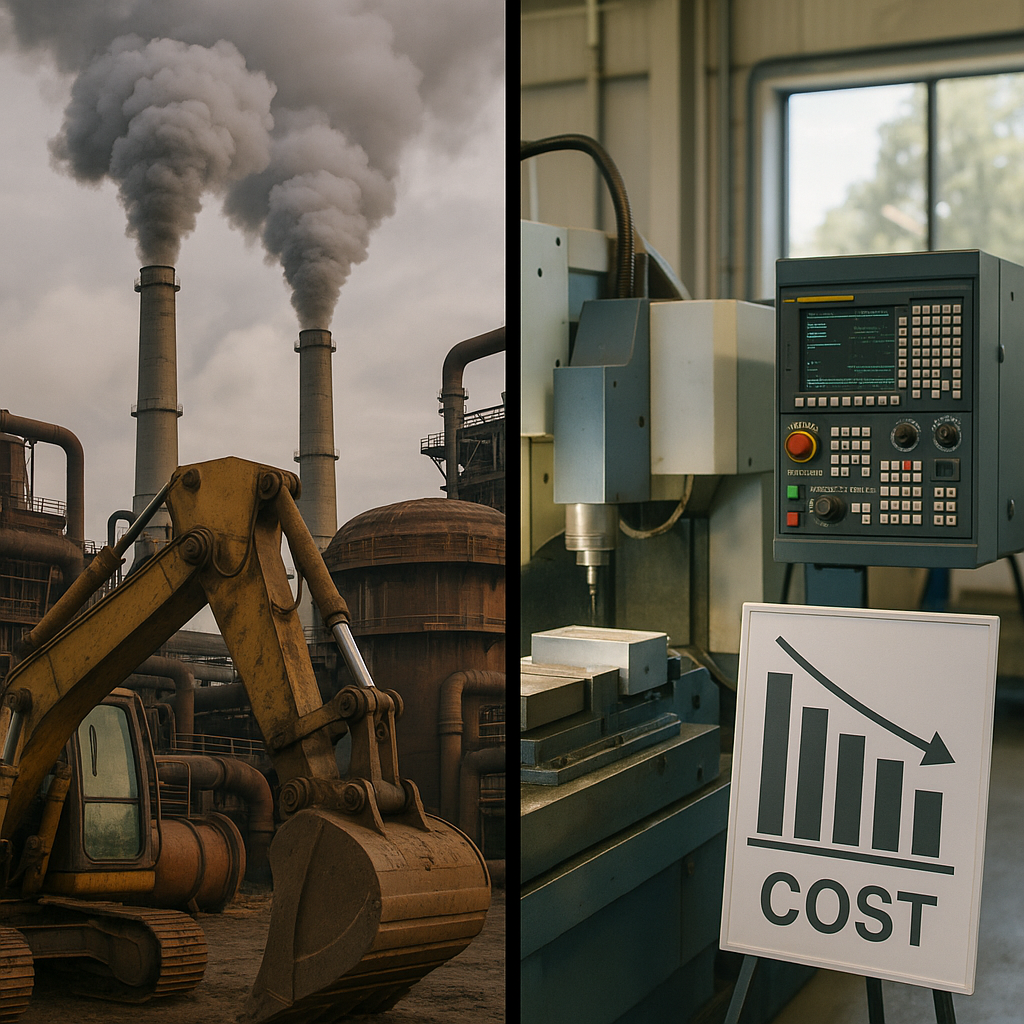5901 Botham Jean Blvd, Dallas, TX 75215
Know the Difference Between Hard Scrap and Soft Scrap in Metal Recycling
October 22, 2025In the metal recycling industry, not all scrap is equal. The industry classifies metal waste into categories to streamline processing and maximize recovery value. Two primary classifications are hard scrap and soft scrap, which guide recyclers in choosing appropriate handling methods and processing techniques.
Hard scrap consists of larger, solid metal pieces that maintain structural integrity. This category includes worn machine components, discarded tools, industrial equipment parts, and other substantial metal objects requiring minimal processing before melting. These items typically have defined shapes and considerable weight, making them valuable for recycling operations.
Soft scrap, in contrast, comprises metal in smaller, less cohesive forms. This includes metal dust, turnings, chips, shavings, and powders generated during manufacturing processes like drilling, milling, and grinding. Although these materials contain valuable metal content, they require different handling approaches due to their physical properties.
How Does Hard Scrap Processing Differ from Soft Scrap Processing?
Hard scrap processing follows a distinctly different path than soft scrap handling in metal recycling operations. Hard scrap consists of bulky, solid metal items like vehicle parts, structural beams, and industrial equipment, which require significant size reduction before entering the melting phase of recycling.
In hard scrap processing, large hydraulic machinery breaks down these substantial metal pieces. Powerful shredders and shears cut through thick materials, reducing them to manageable fragments. For instance, when processing an old car frame, industrial shredders must first transform it into smaller pieces suitable for furnace loading.
The melting process for hard scrap is relatively straightforward once size reduction is complete. These dense materials typically have consistent compositions, making them easier to process in high-temperature furnaces. Steel and iron hard scrap requires higher melting temperatures than other metals, but follows a predictable melting pattern.
Soft Scrap Handling Requires Different Approaches
Soft scrap presents different challenges. This category includes metal turnings, chips, shavings, and thin-gauge materials commonly generated during manufacturing operations. The primary issue with soft scrap is its low density and high surface area.
Rather than cutting or shredding, soft scrap typically requires compacting or briquetting. This process compresses loose metal particles into dense blocks or briquettes. For example, metal turnings from a machine shop might be collected and fed through a briquetting press to create compact forms that can be handled efficiently.
Soft scrap melting demands special attention due to its composition variability. The high surface-to-volume ratio means these materials oxidize more readily during melting. When processing aluminum soft scrap, recyclers must carefully manage furnace conditions to prevent excessive material loss through oxidation.
Processing Equipment Differences
Equipment needs vary significantly between hard and soft scrap processing. Hard scrap operations rely on robust shredders, guillotine shears, and heavy-duty cutting systems. These machines must withstand tremendous forces when reducing thick metal items to smaller sizes.
Soft scrap handling employs different machinery. Briquetting presses, compactors, and baling equipment transform loose materials into dense forms. For copper wire turnings, specialized compacting systems might create dense blocks that maximize material recovery during subsequent melting.
The sorting phase also differs significantly. Hard scrap often requires magnetic separation and density-based sorting techniques. Soft scrap processing may incorporate eddy current separation and sophisticated optical sorting systems to handle the varied composition of manufacturing residuals.
Transportation considerations further highlight the differences between these scrap types. Hard scrap’s weight and density make it economical to transport even without preprocessing. Soft scrap, however, must typically be densified through compacting before transportation becomes financially viable due to its otherwise low weight-to-volume ratio.
What Are the Key Challenges in Processing Hard vs Soft Scrap?

Processing hard scrap demands significant energy resources for size reduction. These dense materials require heavy-duty industrial shredders and cutting equipment that consume substantial power. Shredding hard metals like steel can need up to 50% more energy compared to softer alternatives.
Contamination is another major hurdle with hard scrap. Non-metallic materials often remain attached to components, including rubber gaskets, plastic housings, and synthetic linings. These contaminants must be completely removed to prevent quality issues in the recycled product.
High-temperature blast furnaces are usually required for hard scrap due to higher melting points. Steel recycling uses oxygen furnaces to refine impurities and form high-quality alloyed products. This additional heating step increases overall energy consumption in the recycling process.
Soft scrap presents different challenges, especially in composition analysis. The variable nature of soft scrap makes material identification difficult. Without precise data, processors struggle with fair pricing and appropriate processing methods.
Impurities tend to be higher in soft scrap materials, including surface coatings, oils, greases, and other substances that complicate processing. Oils specifically can impact the quality of recycled materials by preventing proper adhesion of later-applied protective coatings.
Processing equipment for soft scrap requires specific technical specifications. Soft metals are typically baled, compacted, or granulated rather than shredded, needing specialized machinery for these processes.
Separation technology plays a crucial role in addressing these challenges. Magnetic separation is effective for ferromagnetic hard scrap like iron and steel. Soft scrap often needs more complex eddy current separation or density-based technologies for proper sorting.
Pre-cleaning is essential for both types of scrap, especially soft scrap with high oil content. Without proper degreasing, sophisticated processing methods may fail to produce high-quality recycled materials.
Market volatility affects both types differently. Hard scrap typically maintains stable pricing due to consistent demand from construction and manufacturing sectors. Soft scrap prices fluctuate more dramatically based on specialized industry demands.
Despite these challenges, both scrap types present valuable recycling opportunities. Modern processing facilities are increasingly implementing advanced sorting technologies and pre-treatment methods to maximize recovery rates from both hard and soft scrap.
| Scrap Type | Energy Requirement | Contamination Challenges |
|---|---|---|
| Hard Scrap | High energy required for shredding and melting | Non-metallic attachments like rubber and plastic |
| Soft Scrap | Lower energy required for compacting and melting | Higher impurity levels including oils and surface coatings |
How Do Recycling Technologies Address Hard and Soft Scrap Differently?

The recycling industry differentiates between hard and soft scrap materials, each requiring specific processing methods. Hard scrap includes solid, intact items like worn tools, indexable inserts, and wear parts, while soft scrap consists of sludge, dust, chips, and powdery materials. This distinction influences the selection of suitable recycling technologies.
Thermal Zinc Recycling for Hard Scrap
For hard scrap materials, particularly tungsten carbide components, thermal zinc recycling sets the standard. This process efficiently preserves material integrity.
It starts with placing hard metal scrap with zinc in graphite boats inside specialized furnaces. As zinc melts, it reacts with the cobalt binder phase, causing an expansion that transforms the solid carbide into a porous structure.
This change breaks down the cemented carbide into thin layers without altering its chemical composition. Zinc is then distilled off and recovered, leaving a porous mass of tungsten carbide and cobalt that can be milled into powder.
The recycled powder retains over 99% of the original tungsten carbide, maintaining its grain structure and metallic cobalt. This material preservation makes thermal zinc recycling especially valuable for high-quality carbide production.
Chemical Processes for Soft Scrap
Soft scrap materials typically undergo chemical processing methods that dissolve components to their atomic levels. This approach suits materials lacking structural integrity or containing impurities that complicate physical separation.
In chemical recycling, all used carbide components dissolve and are then refined through extraction and crystallization. After thermal treatment, they are converted back into reusable raw products.
This process requires minimal energy compared to primary material production. An added advantage is the separate extraction of cobalt, which is particularly beneficial given its rising market price and limited supply.
LIBS Technology: Innovating Both Hard and Soft Scrap Sorting
Laser-Induced Breakdown Spectroscopy (LIBS) represents a technological advance that benefits both hard and soft scrap recycling, though it is notably transformative for mixed and soft materials.
LIBS uses high-powered lasers to analyze metals at a micro level. When the laser targets a metal sample, it vaporizes a small portion, creating plasma that emits light at specific wavelengths, identifying the elements present.
In scrap yards processing mixed materials, LIBS technology distinguishes various metals and alloys with remarkable precision. The system can identify and separate aluminum, steel, copper, and mixed alloys in real-time, greatly improving sorting efficiency.
While helpful for hard scrap sorting, LIBS technology excels with soft and mixed scrap where visual identification is impossible. The technology detects trace elements, enabling the recovery of valuable materials often lost in conventional recycling processes.
| Recycling Method | Material Type | Process Description | Key Benefits |
| Thermal Zinc Recycling | Hard Scrap | Uses zinc on graphite boats to break down tungsten carbide into layers, preserving its integrity. | Over 99% recovery of tungsten carbide in its original form, maintains cobalt content. |
| Chemical Recycling | Soft Scrap | Dissolves components into atomic constituents, then refines and crystallizes for reuse. | Low energy input, cobalt is separated as a valuable by-product. |
Advanced sorting technologies like LIBS have revolutionized recycling operations by reducing labor costs, minimizing contamination, and increasing recovery rates of valuable materials. Automated systems using LIBS process large volumes of mixed scrap with high accuracy, making previously uneconomical recycling streams viable.
As recycling technology evolves, differentiating processing methods for hard and soft scrap remains crucial for maximizing material recovery and ensuring high-quality recycled products. By aligning the right technology with each scrap type, recyclers can optimize both environmental and economic outcomes.
What Are the Economic and Environmental Implications of Hard vs Soft Scrap Processing?
Economic Differentials Between Hard and Soft Scrap
Hard scrap metals provide notable economic advantages due to pricing stability. The consistent composition and physical properties make valuation more predictable for recyclers and buyers alike. This stability allows for more reliable revenue forecasting and reduces financial risk.
Processing costs for hard scrap are typically lower than for soft scrap. Hard scrap requires less intensive sorting, separation, and cleaning, leading to more streamlined processes. Materials like steel beams, railroad tracks, and heavy machinery parts need minimal preparation before melting and reuse.
Soft scrap has a different economic profile with more volatile pricing patterns. Price fluctuations result from inconsistent material composition and the presence of contaminants or coatings. Despite these challenges, properly processed soft scrap can yield valuable materials, especially from copper- and aluminum-rich sources.
Processing Cost Comparison
The processing requirements for these scrap types result in notable cost differences. Hard scrap processing often involves straightforward shearing, cutting, and baling operations, translating to lower labor and energy costs during preparation.
Soft scrap demands more complex processing techniques, requiring thorough separation to isolate valuable components from less desirable elements. This additional processing includes shredding, density separation, and sometimes chemical treatments to remove contaminants, significantly increasing handling and processing costs.
| Processing Type | Cost | Handling Steps | Equipment Used |
| Hard Scrap | Lower | Shearing, Cutting, Baling | Shredders, Guillotine Shears |
| Soft Scrap | Higher | Shredding, Separation, Chemical Treatments | Compact Press, Briquetting Machines |
Environmental Benefits of Both Scrap Types
From an environmental perspective, recycling both hard and soft scrap offers substantial benefits compared to primary metal production. Recycling steel scrap reduces carbon dioxide emissions by 58% to 73% compared to mining and processing virgin materials, significantly contributing to greenhouse gas mitigation.
Energy consumption drops dramatically through metal recycling. Aluminum recycling saves 95% of the energy required to produce new aluminum from bauxite ore. Similarly, steel recycling reduces energy usage by roughly 60% compared to production from iron ore, directly lowering the carbon footprint of recycled metal products.
Resource conservation is another critical environmental benefit. Recycling reduces the need for environmentally destructive mining operations that cause deforestation, soil erosion, and water pollution. Processing both hard and soft scrap helps preserve natural habitats and reduce the environmental degradation associated with extracting virgin materials.
Waste Diversion Impact
Both scrap types significantly contribute to waste diversion efforts. Metals sent to recycling facilities avoid landfill disposal, where they would otherwise occupy valuable space for centuries. Hard scrap, with its higher volume-to-value ratio, makes substantial contributions to landfill avoidance.
Soft scrap recycling prevents potentially harmful materials from entering the environment. Items like wire insulation, electronic components, and lightweight metal packaging contain substances that could contaminate soil and water if improperly discarded. Processing these materials keeps potential contaminants contained and allows for proper handling.
Water conservation is another benefit of metal recycling. Recycling processes use significantly less water than primary metal production. Secondary metal production from both hard and soft scrap reduces water usage by approximately 40% compared to virgin material extraction and processing, helping preserve this essential resource.
Conclusion: Optimizing Hard and Soft Scrap Processing for Maximum Efficiency

Effective metal recycling requires tailored approaches for hard and soft scrap. Understanding their unique characteristics and processing requirements is essential. Hard scrap benefits from shearing and baling techniques, which increase density and facilitate transportation, while soft scrap requires specialized sorting technology and careful handling to prevent contamination.
By using technologies like sensors, automation, and data-driven inventory management, recyclers can optimize recovery rates and minimize environmental impact. The industry focuses on cold refining processes—sorting, cleaning, and densification—as a cost-effective way to process both hard and soft scrap before they reach melting facilities. For your recycling needs, contact Okon Recycling at 214-717-4083.
